What is Data Extraction? Definition, Techniques & Examples
From seamless image retouching to stunning visual enhancements, sound photo editing techniques transform passive property listings into captivating visual experiences. Photo editing and retouching done right, can amplify buyer engagement, maximize business impact, and propel your MLS site to the next level.
Photos of real estate properties directly impact sales by either grabbing a buyer’s attention or prompting the buyer to move on. As shown in a recent joint survey by Google and the National Association of Realtors® in the USA, 70 percent of surveyed home buyers say they use photos and videos to assess the interiors of any home they wished to purchase. This is why MLS sites consider real estate photo editing and retouching as essential services.
Table of Contents
Real estate is as much about price and structure as it is about a building’s looks and associated status. So, making sure that real estate photos are visually appealing and they highlight the best features of a property, is a crucial task for the success of a property listing. And thus photo editing techniques become essential tools for an MLS site’s success. Some hire expert photo editors in-house. Others outsource real estate photo editing to specialized companies. Big MLS sites do both.
Examples of successful MLS listings
Trompeter Real Estate has some excellent real estate photography examples and a well-defined UI.
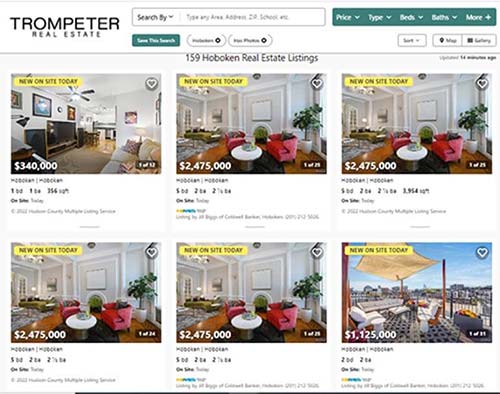
This Facebook Real Estate Ad from Zephyr Real Estate utilizes a well-lit, edited photo of the space that entices potential buyers to check out the home.
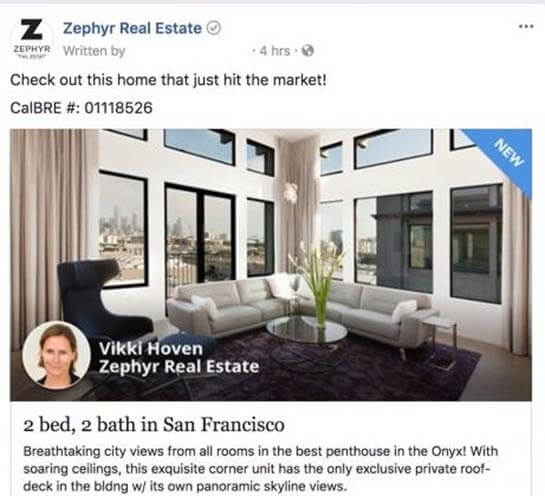
|
Real Estate Photo Editing |
Real Estate Photo Retouching |
|---|---|
| Focuses on improving the overall quality and appeal of raw images | Focuses on enhancing specific elements within an image to make it more visually appealing |
| Involves correcting exposure, adjusting colors, cropping, straightening, lens correction, and HDR blending. | Involves removing imperfections, adding, or modifying elements, and applying creative effects. |
| Aims to create a visually appealing composition by balancing brightness, contrast, and color balance. | Techniques include object removal, sky replacement, virtual staging, grass and foliage enhancement, and window reflection removal. |
| Addresses issues like distortion caused by wide-angle lenses and aligning the image for a balanced composition | Creates a polished and professional look by eliminating unwanted elements and distractions and improving the appearance of specific features. |
Photo editing techniques allow you to enhance your images, correct imperfections, and create stunning visuals. They are used by experts to create those professional real estate photos you find on property portals.
The choice of photo editing methods depends upon the quality of raw image, context, and objectives. But they usually include a combination of the following top 12 real estate photo editing and retouching techniques.
Background:
Accurate color representation is crucial to the depiction of any property. Colors directly impact the perception of a property. As online buyers rely on photos to gauge a space and its features, color inaccuracy can mislead buyers and even disappoint them during site visit. It is essential to render colors in professional real estate photos with accuracy.
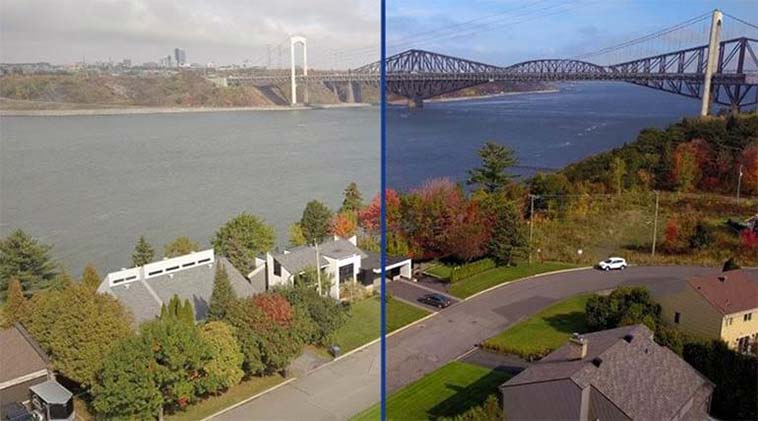
How it works:
To achieve the best color representation possible, real estate editors fine-tune colors in their photos. Correcting color issues involves the following techniques:
Background:
Property photos commonly suffer from perspective issues. For example, it happens with converging verticals, when using wide-angle lenses. These lenses could distort images converging vertical lines and thus rendering an inaccurate representation of the property. Perspective distortions should be eliminated to ensure a better representation of a property. The perspectives need to be aligned with straight and parallel vertical lines, providing viewers a better look and feel of the space.
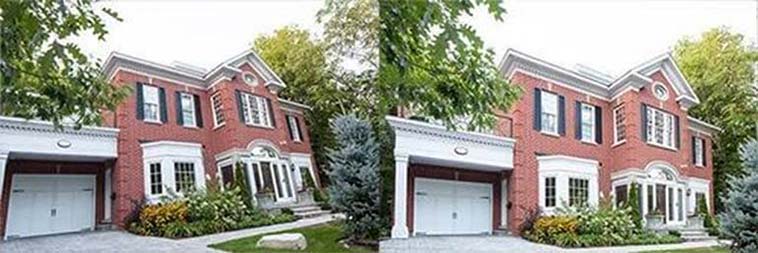
How it works:
Editors are always searching for real estate photography editing tips, and better ways to correct perspective distortions. They use software tools for perspective correction and to selectively adjust angles and proportions. Straightening vertical lines is the first step for creating visually pleasing representations of the property. Here are some techniques that work:
Correcting perspective distortions ensure enable prospective buyers to make informed decisions by observing an accurate portrayal of the property.
Background:
Image noise impacts the quality of professional real estate photos negatively. Grainy or speckled patterns, noticeable in some property photos, are usually captured in low-light conditions or with faulty high ISO settings. The noise detracts viewers from the real appeal of the photo and even dilutes the viewer’s perception of the property.

How it works:
To achieve a cleaner look in these photos, it is essential to minimize noise. Here are some techniques that address the noise issues:
Points to Note: It is important for photo editors to strike a balance between reducing noise and maintaining image sharpness. Excessive noise reduction will render a “plastic” appearance to the photos. Judicious use of noise tools with proper evaluation of final results can help editors to nail the professional look that they need.
Background:
Lighting probably has the biggest impact on real estate photography. Effective lighting techniques highlight the best features of a property, influence its perception, and capture the true essence of the space. Without proper lighting and balance in shadows, a property can never be presented in its true light, pun intended.
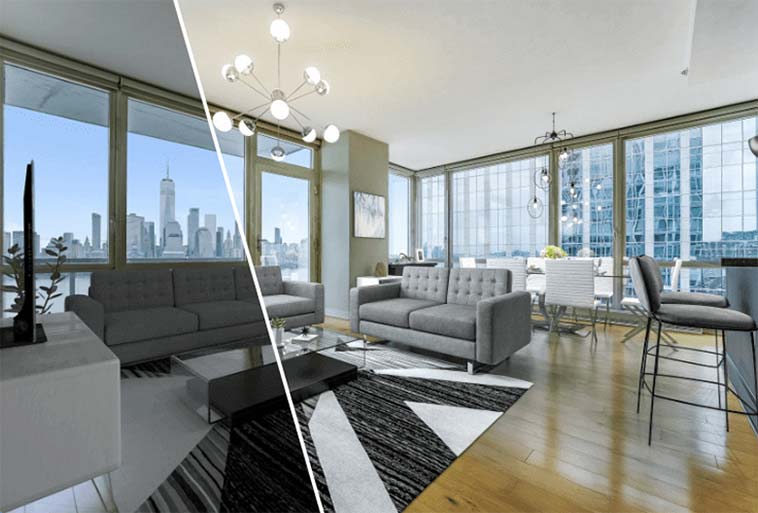
How it works:
Here are some techniques that we use to manage light and shadows effectively:
Point to note: Tweaking the afore-mentioned settings are extremely useful in day-to-dusk transformations where clients demand daylight settings to be changed to night-time.
Background:
Eliminating unwanted objects and reflections is crucial to present real estate photos effectively. A clean and visually appealing image focuses on key features of the property. And real estate photos shine the best when every element within the photo adds charm and chutzpah to the appearance of the space.
Editors eliminate elements that are not desirable within the frame, including personal belongings or items that obstruct the view of the space. Also, reflections from flash photography could bounce from shiny surfaces like mirrors and distract attention from the property’s aesthetics. Removing or reducing these flash reflections ensures that viewers can see the property clearly without any distractions.
Here are some techniques used regularly by real estate photo editors for object removal as well as for eliminating shadows and reflections:
Points to note: When removing distracting objects from real estate images, exercise caution and ensure the changes are seamless. You need to pay attention to detail and select replacements precisely, matching textures and colors for a professional final result.
Background:
Attractive lawns and skies boost the appeal of real estate photos in exterior shots. These elements present image aesthetics and significantly influence the desirability of the property. And editors can develop visually striking images by enhancing lawns and skies.

How it works:
The following are techniques are employed regularly to enhance exterior images:
Background:
Sharpness and clarity contribute immensely to the overall image quality to build a polished and professional look. A sharp and clear photo can showcase property details perfectly, ensuring that viewers can accurately perceive its features and be sure of what it brings to the table.
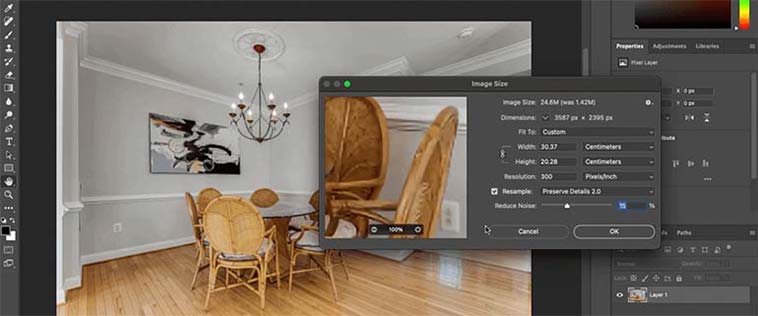
How it works:
There are several techniques editors use to sharpen images and enhance their overall clarity:
Points to note: Strike a balance between boosting sharpness and maintaining a natural tone to the photos. Use clarity adjustment judiciously, as their excessive use makes them look unnatural. Pursue subtle application of sharpening techniques to achieve a professional and pleasing result. Find out how property images captured by 20+ photographers were post-processed to resolve imperfections in the raw images.
Background:
HDR (High Dynamic Range) is a technique that captures a wider range of light information in a scene. It blends multiple exposures of the same shot together to achieve a balanced final image with smart tonal range and better realism. With HDR you can showcase real estate interiors with an expanded dynamic range, or a wider range of lighting conditions.
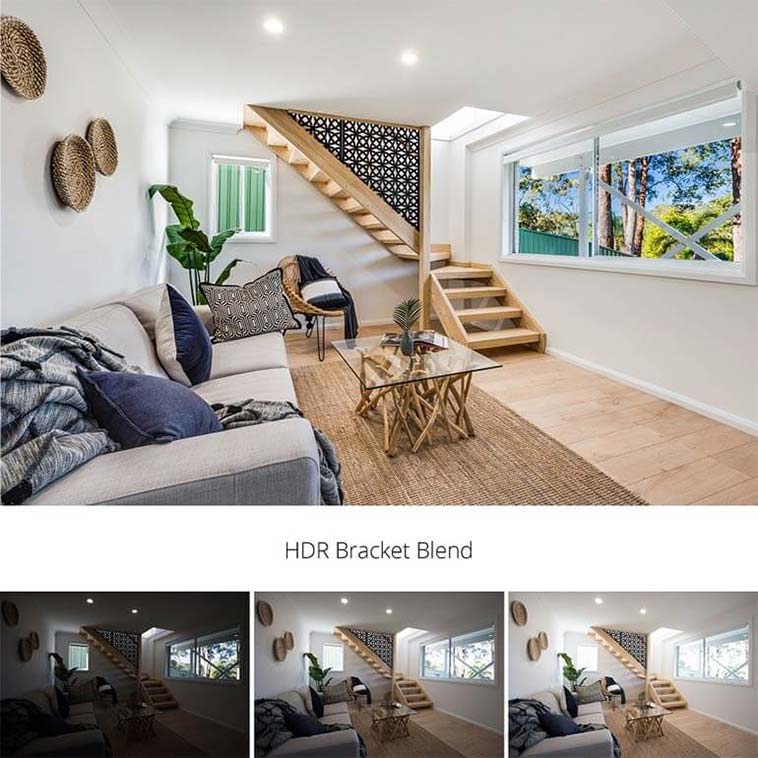
How it works:
To achieve a balanced and realistic HDR look in real estate photography, the following techniques are used:
The goal of automatic and manual HDR techniques is to develop an attractive property image that retains details from highlights and shadows and provides a realistic representation of the space.
Background:
Common lens distortions, such as barrel distortion affect the straightness of lines on real estate property photos. The distortions introduce color fringing that needs to be identified and corrected to ensure that the images are visually pleasing and free from distractions. Some of the problems include barrel distortion that causes straight lines to appear curved like a barrel.
This problem causes architectural lines like door frames to appear bent. On the other hand, chromatic aberration refers to a lens that fails to focus different wavelengths of light resulting in color fringing. Seen colored halos? These halos crop up, especially in areas where contrasting tones meet.
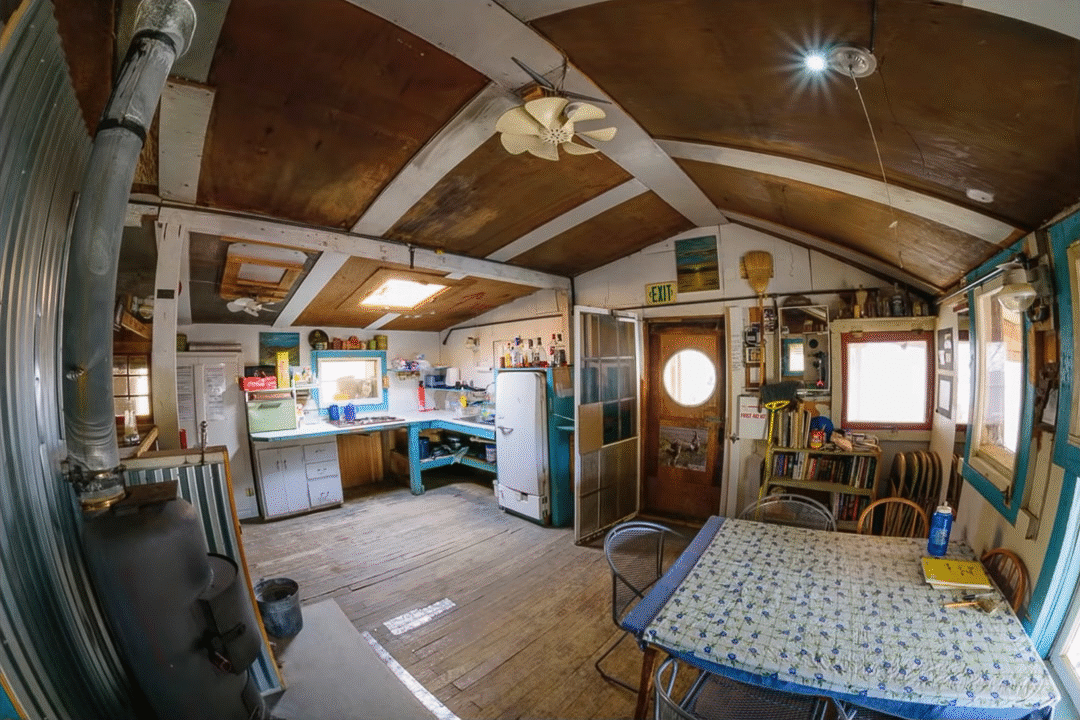
How it works:
Points to note: Automatic correction tools for lens profiles are a good starting point for correcting lens distortions, while requiring certain manual adjustments in some cases. Manual adjustments offer finer control and customization, especially when addressing unusual distortions.
Elimination of chromatic aberration and barrel distortion implies proper attention to detail and you have to be diligent and careful about removing these issues.
Background:
Proper white balance and color adjustments play a vital role in real estate photos. They ensure accurate representation of colors and define the atmosphere within those pictures.
White balance ensures accurate reproduction of white tones in an image, which impact the overall temperature and perception of the shades in the setting. Adjusting white balance eliminates color casts impacted by light sources, projecting a natural appearance. Additionally, hue and saturation levels in real estate photos impact the mood of the setting, which when tweaked create a desired aesthetic.
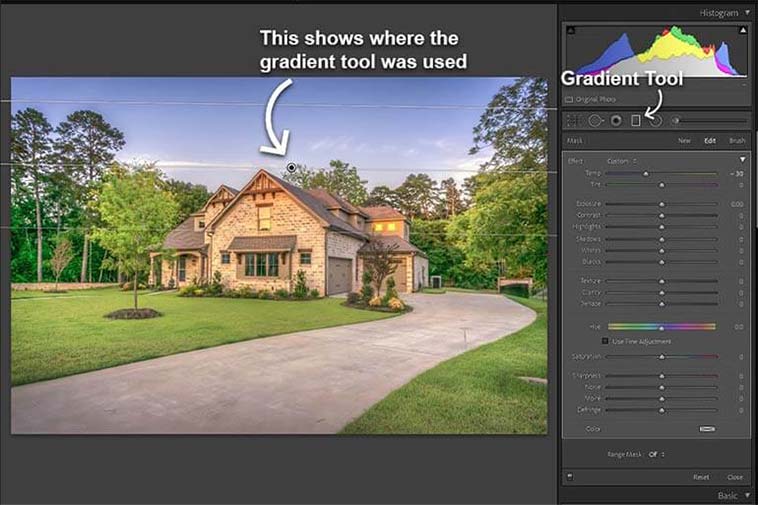
How it works:
Here are some techniques that we use to fine-tune white balance, hue, and saturation in real estate photos:
These settings enable real estate photo editors to achieve proper white balance and precise color reproduction for setting an amiable atmosphere for prospective buyers.
Background:
Digital or virtual staging involves digital addition of furniture, decor, and other elements to property spaces, providing prospective buyers with a sense of possibilities. Digital staging helps them envision how it would feel living in the space.
Virtual staging allows empty properties to be showcased properly, adds a sense of warmth, functionality, and aesthetics to the pictures. By virtually staging a space, buyers can visualize the space with respect to its scale, layout, and potential and how they utilize the space.
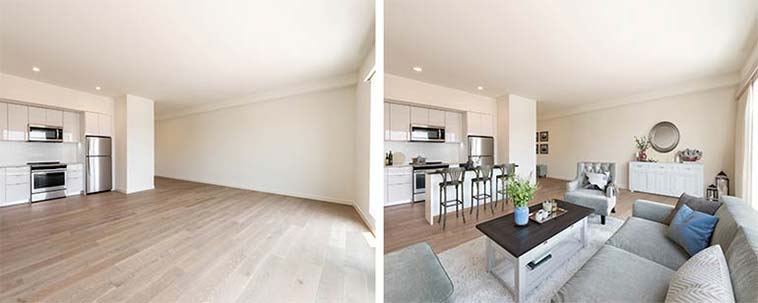
How it works:
Real estate photo editors rely on diverse techniques for digitally staging spaces. This has become a specialized area even within photo editing and provided by many professional virtual staging services. The staging effort includes incorporating various elements in a vacant space:
The staging process also involves the adjustment of the size, position, and orientation of objects to blend seamlessly with the environment.
Professional real estate photo editors are experts in choosing the right furniture and decor to align with the space and the residential style and target market. They retain the individuality of the property without using cliché designs. Additionally, the editors use panoramic stitching techniques that can stitch multiple scenes from different angles to get a single, unbroken image of the property with the lawns, the home, the surroundings, and also the sky.
Points to note: While virtual staging can boost the visual presentation of a property, the edits need to be ethical and transparent. The representations need to carry a disclaimer that the images are digitally altered or staged to maintain honesty and avoid misleading prospective buyers.
Background:
Batch editing in real estate photography helps editors to maintain visual consistency across multiple photos and thus save on valuable editing time. Batch editing helps editors to apply consistent adjustments to several photos on a simultaneous basis. Real estate editors often need to edit photos of the same property or space that feature similar lighting conditions, composition frame, and settings. This is especially crucial in setting a cohesive visual narrative that spells out “professionalism” in every frame.
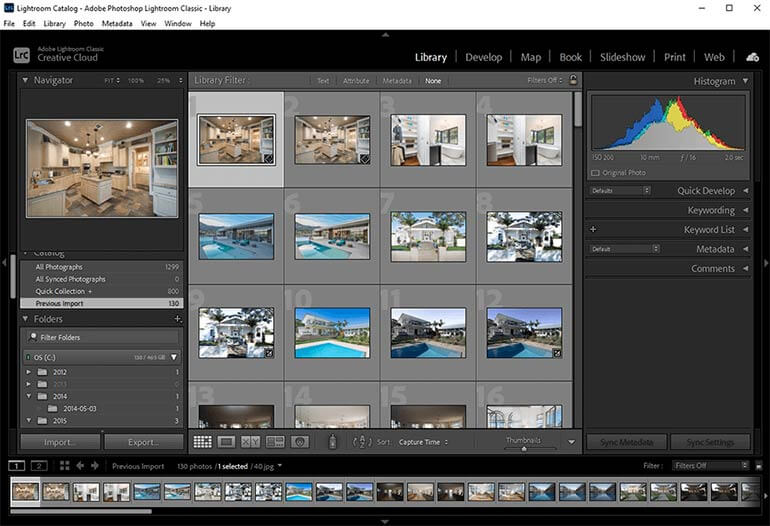
How it works:
To achieve efficient batch editing, our set of editors utilize the following techniques:
Points to note: When performing batch edits, review each image individually to check the adjustments applied to them during the batch process. Although batch editing saves time for consistent adjustments, attention to detail is necessary to fine-tune some individual images.
Want to transform your MLS site with professional-quality real estate photos?
Real estate photo editors for MLS sites have to be extra careful to avoid the following mistakes:

Adobe Lightroom Transform real estate photos: exposure, perspective, color correction.

Adobe Photoshop Fast track real estate photo retouching: compositing, object removal, HDR, etc.

Adobe InDesign Streamline real estate marketing materials: layout, typography, photo placement, etc.

Autodesk 3DS Max Create stunning real estate visualizations, 3D renderings, animations, etc.

Adobe Illustrator Design real estate vector graphics, logos, and scalable illustrations.
Attract more property buyers with eye-catching real estate visuals.
Real estate photography editing is expected to witness significant advancements that will propel and enhance the visual representation of real estate properties. The push will be for immersive experiences for buyers everywhere. Here are the expected future trends of photo editing in the real estate domain:

Real estate photo editing would become more specialized with human experts supervising AI-based modifications in the future. New tools will propel faster editing with transitions to virtual tours. These developments will boost the visual representation of properties, deliver immersive experiences, and streamline decision-making.
Legal and ethical considerations play a crucial role in the editing process of real estate photos. Without paying heed to the legalities involved, real estate photo editors could face issues. Here are the key aspects to keep in mind:
Hitech BPO uses cutting-edge technologies to enhance the visual experience offered by their clients in more ways than one.
We have a team of expert real estate photo editors and experiential specialists who offer professional image editing services backed by their exceptional photo editing experience. We already utilize AI-based techniques for MLS sites, leveraging advanced editing software tools easily. The team stays updated with the latest advancements in AI and upholds the highest standards in maintaining precision and efficiency in making changes to real estate photos.
Here are the advantages of outsourcing real estate photo editing to experts like Hitech BPO:
Hitech BPO has over the years helped MLS portal owners with competent and unique real estate photography editing tips and services so that its clients can focus on their core business activities, ensuring increased productivity and quick turnaround times.
Our team is made of highly skilled graphic designers specialized in real estate photo editing. They can swiftly transform ordinary images into spectacular property photos. Check out how we helped a real estate photographer with an effective digital catalog of stunningly edited photos.
Real estate photo editing plays an important role in capturing the attention of potential buyers and enhancing the visual appeal of properties. Although several techniques are used for editing the photos including hue and saturation settings, correction of perspective distortions, balance in lighting and colors, object removal, and virtual staging, a proper understanding and expertise of photo editing is a must to showcase properties in the best light.
Looking towards the future, one can expect further advancements in photo editing based on AI-based modifications, quick editing techniques, and transition to 3D visualizations and AR.
Hitech BPO has a long experience in real estate photo editing. And as AI tools begin to level the field, it is the human expert who will spell the difference. Our skilled professionals can spell the difference between buyer engagement and disappointment.
What’s next? Message us a brief description of your project.
Our experts will review and get back to you within one business day with free consultation for successful implementation.
Disclaimer:
HitechDigital Solutions LLP and Hitech BPO will never ask for money or commission to offer jobs or projects. In the event you are contacted by any person with job offer in our companies, please reach out to us at info@hitechbpo.com
Leave a Reply